Related Research Articles

A condom is a sheath-shaped barrier device used during sexual intercourse to reduce the probability of pregnancy or a sexually transmitted infection (STI). There are both male and female condoms.
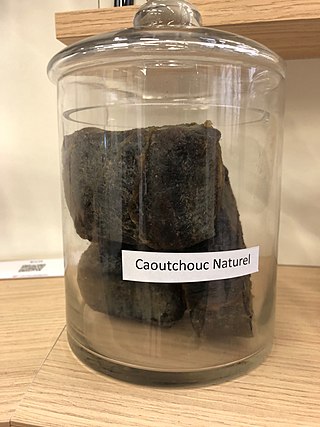
Rubber, also called India rubber, latex, Amazonian rubber, caucho, or caoutchouc, as initially produced, consists of polymers of the organic compound isoprene, with minor impurities of other organic compounds. Thailand, Malaysia, Indonesia, and Cambodia are four of the leading rubber producers.

Allergies, also known as allergic diseases, are various conditions caused by hypersensitivity of the immune system to typically harmless substances in the environment. These diseases include hay fever, food allergies, atopic dermatitis, allergic asthma, and anaphylaxis. Symptoms may include red eyes, an itchy rash, sneezing, coughing, a runny nose, shortness of breath, or swelling. Note that food intolerances and food poisoning are separate conditions.
An allergen is a type of antigen that produces an abnormally vigorous immune response in which the immune system fights off a perceived threat that would otherwise be harmless to the body. Such reactions are called allergies.

p-Phenylenediamine (PPD) is an organic compound with the formula C6H4(NH2)2. This derivative of aniline is a white solid, but samples can darken due to air oxidation. It is mainly used as a component of engineering polymers and composites like kevlar. It is also an ingredient in hair dyes and is occasionally used as a substitute for henna.
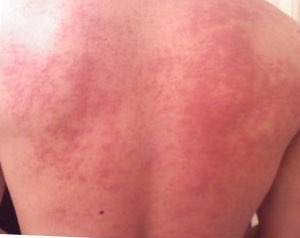
A food allergy is an abnormal immune response to food. The symptoms of the allergic reaction may range from mild to severe. They may include itchiness, swelling of the tongue, vomiting, diarrhea, hives, trouble breathing, or low blood pressure. This typically occurs within minutes to several hours of exposure. When the symptoms are severe, it is known as anaphylaxis. A food intolerance and food poisoning are separate conditions, not due to an immune response.

Latex allergy is a medical term encompassing a range of allergic reactions to the proteins present in natural rubber latex. It generally develops after repeated exposure to products containing natural rubber latex. When latex-containing medical devices or supplies come in contact with mucous membranes, the membranes may absorb latex proteins. In some susceptible people, the immune system produces antibodies that react immunologically with these antigenic proteins. Many items contain or are made from natural rubber, including shoe soles, pen grips, hot water bottles, elastic bands, rubber gloves, condoms, baby-bottle nipples, and balloons; consequently, there are many possible routes of exposure that may trigger a reaction. People with latex allergies may also have or develop allergic reactions to some fruits, such as bananas.

Parthenium argentatum, commonly known as the guayule, is a perennial woody shrub in the family Asteraceae that is native to the rangeland area of the Chihuahuan Desert; including the southwestern United States and northern Mexico. It was first documented by J.M. Bigelow in 1852 through the Mexican Boundary Survey and was first described by Asa Gray. Natural rubber, ethanol, non-toxic adhesives, and other specialty chemicals can be extracted from guayule. An alternative source of latex that is hypoallergenic, unlike the normal Hevea rubber, can also be extracted. While Castilla elastica was the most widely used rubber source of Mesoamericans in pre-Columbian times, guayule was also used, though less frequently. The name "guayule" derives from the Nahuatl word ulli/olli, "rubber".
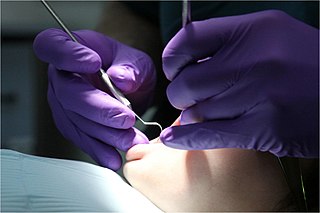
Medical gloves are disposable gloves used during medical examinations and procedures to help prevent cross-contamination between caregivers and patients. Medical gloves are made of different polymers including latex, nitrile rubber, polyvinyl chloride and neoprene; they come unpowdered, or powdered with corn starch to lubricate the gloves, making them easier to put on the hands.
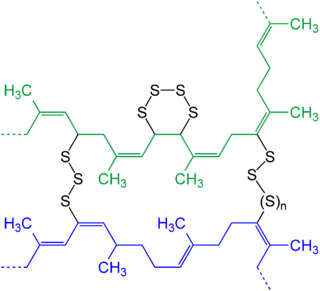
In chemistry and biology a cross-link is a bond or a short sequence of bonds that links one polymer chain to another. These links may take the form of covalent bonds or ionic bonds and the polymers can be either synthetic polymers or natural polymers.

Calcium nitrate, also called Norgessalpeter or Norwegian salpeter, is an inorganic compound with the formula Ca(NO3)2(H2O)x. The anhydrous compound, which is rarely encountered, absorbs moisture from the air to give the tetrahydrate. Both anhydrous and hydrated forms are colourless salts. Calcium nitrate is mainly used as a component in fertilizers, but it has other applications. Nitrocalcite is the name for a mineral which is a hydrated calcium nitrate that forms as an efflorescence where manure contacts concrete or limestone in a dry environment as in stables or caverns. A variety of double salts are known including calcium ammonium nitrate decahydrate (NH4NO3·5Ca(NO3)2·10H2O) and calcium potassium nitrate (Ca(NO3)2·4KNO3).

A patch test is a diagnostic method used to determine which specific substances cause allergic inflammation of a patient's skin.

Allergic contact dermatitis (ACD) is a form of contact dermatitis that is the manifestation of an allergic response caused by contact with a substance; the other type being irritant contact dermatitis (ICD).
Cross-reactivity, in a general sense, is the reactivity of an observed agent which initiates reactions outside the main reaction expected. This has implications for any kind of test or assay, including diagnostic tests in medicine, and can be a cause of false positives. In immunology, the definition of cross-reactivity refers specifically to the reaction of the immune system to antigens. There can be cross-reactivity between the immune system and the antigens of two different pathogens, or between one pathogen and proteins on non-pathogens, which in some cases can be the cause of allergies.

Skin allergy testing comprises a range of methods for medical diagnosis of allergies that attempts to provoke a small, controlled, allergic response.
FITkit is an immunological test for measuring natural rubber latex (NRL) allergens from a variety of rubber products, such as gloves.

Latex is an emulsion of polymer microparticles in water. Latexes are found in nature, but synthetic latexes are common as well.
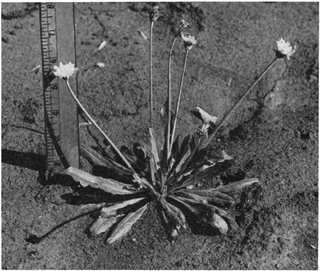
Taraxacum kok-saghyz, often abbreviated as TKS and commonly referred to as the Kazakh dandelion, rubber root, or Russian dandelion, is a species of dandelion native to Kazakhstan, Kyrgyzstan and Uzbekistan, notable for its production of high-quality rubber. T. kok-saghyz was discovered in Kazakhstan in 1932 by Soviet scientists seeking a domestic source of rubber.

Abrasion is the process of scuffing, scratching, wearing down, marring, or rubbing away. It can be intentionally imposed in a controlled process using an abrasive. Abrasion can be an undesirable effect of exposure to normal use or exposure to the elements.

Pro-hevein is a wound-induced and a lectin-like protein from Hevea brasiliensis where it is involved in the coagulation of latex.
References
- 1 2 3 Vystar Corporation. (2009). Vytex NRL Frequently Asked Questions. Retrieved February 9, 2009, from http://www.vytex.com/faq.html Archived 2009-06-28 at the Wayback Machine
- ↑ Company press release, Vystar Corporation and Alatech Healthcare Announce FDA Clearance for Envy Natural Rubber Latex Condom Made with Vytex NRL, May 6, 2009. Retrieved May 13, 2009 from http://www.vytex.com/news Archived 2020-08-24 at the Wayback Machine
- ↑ Staff, Rubber & Plastics News. "Vystar acquires assets of UV Flu Technologies - Rubber & Plastics News". Rubber & Plastics News. Retrieved 2018-05-15.
- ↑ Centers for Disease Control. (1997, June). National Institute for Occupational Safety and Health Publication No. 97-135: Preventing Allergic Reactions to Natural Rubber Latex in the Workplace. Retrieved January 4, 2009, from https://www.cdc.gov/niosh/latexalt.html
- ↑ Bundesen, I. (2008). Natural Rubber Latex: A Concern for Nurses. AORN Journal, 88(2), 197-210.
- ↑ Vystar Corporation. (2008, October). Vytex Natural Rubber Latex Technical Bulletin.
- ↑ Holtzclaw, H.F., Robinson, W.R., Nebergall, W.H. General Chemistry (7th edition). D.C. Heath and Company 1984, 884-885
- ↑ Vystar Corporation and Quant-Tec-Air, Inc. (2008). Vytex Natural Rubber Latex: A Proposed Industry Standard for the Manufacture of Commercial Natural Rubber Products. Duluth, GA: Honeycutt, T., Swanson, M., Doyle, W., Clark, M., & Culp, R.
- ↑ ASTM D5712 - 05e1 Standard Test Method for Analysis of Aqueous Extractable Protein in Natural Rubber and Its Products Using the Modified Lowry Method; retrieved May 29 from http://www.astm.org/Standards/D5712.htm
- ↑ ASTM D6499 - 07 Standard Test Method for The Immunological Measurement of Antigenic Protein in Natural Rubber and its Products; retrieved May 29 from http://www.astm.org/Standards/D6499.htm